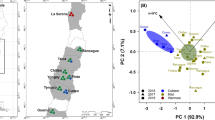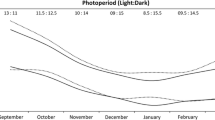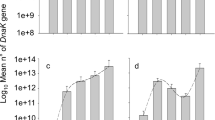Abstract
The rise of temperatures may enable species to increase their activities during winter periods and to occupy new areas. In winter, resource density is low for most species and an increased number of active consumers during this season may produce heightened competitive pressure. In Western France, the aphid parasitoid species Aphidius avenae Haliday has been known to adopt a winter diapausing strategy adjacent to newly sown cereal crops, until recent reports of active winter populations in cereal crops. We investigate how the addition of this species to the winter guild of parasitoids may change the structure of the aphid–parasitoid food web and the host-exploitation strategies of previously occurring parasitoids. We showed that in winter, Aphidius avenae was mostly associated with two aphid species, Sitobion avenae Fabricius and Metopolophium dirhodum Walker, while the generalist species Aphidius rhopalosiphi was restricted to the aphid species Rhopalosiphum padi L. in the presence of Aphidius avenae. Due to this new competition, winter food webs present a higher degree of compartmentalization and lower proportional similarity index values than spring ones. Parasitoid and aphid abundances responded significantly to changes in daily high temperatures, suggesting that the host–parasitoid community structure can be partly predicted by climate. This study demonstrates how a change in the winter strategy of one species of a guild can modify complex interspecific relationships in host–parasitoid systems.



Similar content being viewed by others
References
Andrade TO, Hervé M, Outreman Y, Krespi L, van Baaren J (2013) Winter host exploitation influences fitness traits in a parasitoid. Entomol Exp Appl 147:167–174
Andrade TO, Outreman Y, Krespi L, Plantegenest M, Vialatte A, Gauffre B, van Baaren J (2015) Spatiotemporal variations in aphid-parasitoid relative abundance patterns and food webs in agricultural ecosystems. Ecosphere 6(7):113
Baayen RH (2007) Analyzing linguistic data: a practical introduction to statistics using R. Cambridge University Press, Cambridge
Barton K (2011) MuMIn: multi-model inference. R package version 1.0.0. http://CRAN.r-project.org/package=MuMIn, March 2014
Bates D, Maechler M, Bolker B (2011) lme4: linear mixed-effects models using S4 classes. R package version 0.999375-41. http://CRAN.r-project.org/package=lme4, March 2014
Bloom SA (1981) Similarity indices in community studies: potential pitfalls. Mar Ecol Prog Ser 5:125–128
Colinet H, Muratori F, Hance T (2010) Cold-induced expression of diapause in Praon volucre: fitness cost and morpho-physiological characterization. Physiol Entomol 35:301–307
Danks HV (2007) The elements of seasonal adaptations in insects. Can Entomol 139:1–44
Derocles S (2012) Analyse des communautés de pucerons et de parasitoïdes associés par barcoding moléculaire : les pucerons ont-ils vraiment des ennemis naturels communs ? PhD thesis, Agrocampus-Ouest, Rennes
Dedryver CA, Hullé M, Le Gallic JF, Caillaud M, Simon JC (2001) Coexistence in space and time of sexual and asexual populations of the cereal aphid Sitobion avenae. Oecologia 128:379–388
Devictor V, Clavel J, Julliard R (2010) Defining and measuring ecological specialization. J Appl Ecol 47:15–25
Dixon AFG (1987) Parthenogenetic reproduction and the rate of increase in aphids. In: Minks AK, Harrewijn P (eds) Aphids: their Biology, Natural Enemies and Control Elsevier, Amsterdam, The Netherlands, pp 269–287
Efron B, Tibshirani R (1986) Bootstrap methods for standard errors, confidence intervals, and other measures of statistical accuracy. Stat Sci 1:54–75
Elner RW, Hughes RN (1978) Energy maximization in the diet of the shore crab, Carcinus maenas. J Anim Ecol 47:103–116
Feinsinger P, Spears EE, Poole RW (1981) A simple measure of niche breadth. Ecology 62:27–32
Futuyma DJ (2001) Ecological specialization and generalization. In: Fox CW, Roff DA, Fairbairn DJ (eds) Evolutionary ecology: concepts and case studies. Oxford University Press, Oxford, pp 177–189
Gagic V, Tscharntke T, Dormann CF, Gruber B, Wilstermann A, Thies C (2011) Food web structure and biocontrol in a four-trophic level system across a landscape complexity gradient. Proc R Soc B 278:2946–2953
Gagic V, Hanke S, Thies C, Scherber C, Tomanovic Z, Tscharntke T (2012) Agricultural intensification and cereal aphid–parasitoid-hyperparasitoid food webs: network complexity, temporal variability and parasitism rates. Oecologia 170:1099–1109
Garrett N, Devane ML, Hudson JA et al (2007) Statistical comparison of Campylobacter jejuni subtypes from human cases and environmental sources. J Appl Microbiol 103:2113–2121
Godfray HJC (1994) Parasitoids. Behavioral and evolutionary ecology. Princeton University Press, Princeton
Hance T, van Baaren J, Vernon P, Boivin G (2007) Impact of extreme temperatures on parasitoids in a climate change perspective. Annu Rev Entomol 52:107–126
Honek A (1985) Plant density and abundance of cereal aphids (Hom., Aphidina). J Appl Entomol 100:309–315
Hutchinson GE (1959) Homage to Santa Rosalia or Why are there so many kinds of animals? Am Nat 93:145–159
IPCC (2013) Climate Change 2013 the Physical Science Basis: Final Draft Underlying Scientific-Technical Assessment : Working Group I Contribution to the IPCC Fifth Assessment Report. In: Stocker TF, Qin D, Plattner GK, Tignor M, Allen SK, Boschung J, Nauels A, Xia Y, Bex V, Midgley PM (eds) Cambridge University Press, Cambridge, New York, p 1535
Jarosik V, Honek A, Tichopad A (2003) Comparison of field population growths of three cereal aphid species on winter wheat. Plant Protect Sci 39:61–64
Jeffs C, Lewis OT (2013) Effects of climate warming on host–parasitoid interactions. Ecol Entomol 38:209–218
Kavallieratos NG, Tomanovic Z, Starý P et al (2004) A survey of aphid parasitoids (Hymenoptera: Braconidae: Aphidiinae) of Southeastern Europe and their aphid-plant associations. Appl Entomol Zool 39:527–563
Krespi L (1990) Etude de la biocénose parasitaire des pucerons des céréales dans le bassin de Rennes : cas particulier d’Aphidius uzbekistanicus Luz. PhD thesis, University of Rennes 1
Krespi L, Dedryver CA, Creach V, Rabasse JM, Le Ralec A, Nénon JP (1997) Variability in the development of cereal aphid parasitoids and hyperparasitoids in oceanic regions as a response to climate and abundance of hosts. Environ Entomol 26:545–551
Le Lann C (2009) Partage de la ressource au sein d’une guilde : des histoires de vie, comportements et réactions à la température contrastés. PhD thesis, University of Rennes 1
Le Lann C, Roux O, Serain N, van Alphen JJM, Vernon P, van Baaren J (2011a) Thermal tolerance of sympatric hymenopteran parasitoid species: does it match seasonal activity? Physiol Entomol 36:21–28
Le Lann C, Wardziak T, van Baaren J, van Alphen JJM (2011b) Thermal plasticity of metabolic rates linked to life-history traits and foraging behaviour in a parasitic wasp. Funct Ecol 25:641–651
Lee JE, Slabber S, van Vuuren BJ, van Noort S, Chown SL (2007) Colonisation of sub-Antarctic Marion Island by a non-indigenous aphid parasitoid Aphidius matricariae (Hymenoptera, Braconidae). Polar Biol 30:1195–1201
Legrand MA, Colinet H, Vernon P, Hance T (2004) Autumn, winter and spring dynamics of aphid Sitobion avenae and parasitoid Aphidius rhopalosiphi interactions. Ann Appl Biol 145:139–144
Lumbierres B, Starý P, Pons X (2007) Seasonal parasitism of cereal aphids in a Mediterranean arable crop system. J Pest Sci 80:125–130
MacArthur R, Levins R (1967) The limiting similarity, convergence and divergence of coexisting species. Am Nat 101:377–385
Mehmejad MR, Copland MJW (2005) Diapause strategy in the parasitoid Psyllaephagus Pistaciae. Entomol Exp Appl 116:109–114
Memmott J, Godfray HCJ, Gauld ID (1994) The structure of a tropical host–parasitoid community. J Anim Ecol 63:521–540
Peñuelas J, Sardans J, Estiarte M (2013) Evidence of current impact of climate change on life: a walk from genes to the biosphere. Global Change Biol 19:2303–2338
Pettitt AN (1979) A non-parametric approach to the change-point problem. Appl Stat 28:126–135
Poisot T, Bever JD, Nemri A, Thrall PH, Hochberg ME (2011) A conceptual framework for the evolution of ecological specialisation. Ecol Lett 14:841–851
Polgár LA, Darvas B, Völkl W (1995) Induction of dormancy in aphid parasitoids: implications for enhancing their field effectiveness. Agric Ecosyst Environ 52:19–23
Rabasse JM, Dedryver CA (1983) Biologie des pucerons des céréales dans l’Ouest de la France. III. Action des hyménoptères parasites sur les populations de Sitobion avenae F., Metopolophium dirhodum Wlk. et Rhopalosiphum padi L. Agronomie 3:779–790
R Development Core Team (2014) R: a language and environment for statistical computing. R Foundation for Statistical Computing, Vienna. http://www.R-project.org/, March 2014
Sampaio MV, Bueno VHP, Rodrigues SMM, Soglia MCM, De Conti BF (2007) Development of Aphidius colemani Viereck (Hym.: Braconidae, Aphidiinae) and alterations caused by the parasitism in the host Aphis gossypii Glover (Hem.: Aphididae) in different temperatures. Neotropic Entomol 36:436–444
Stuble KL, Rodriguez-Cabal MA, McCormick GL, Juric I, Dunn RR, Sanders NJ (2013) Tradeoffs, competition, and coexistence in eastern deciduous forest ant communities. Oecologia 171:981–992
van Asch M, Salis L, Holleman LJM, van Lith B, Visser ME (2013) Evolutionary response of the egg hatching date of a herbivorous insect under climate change. Nat Clim Change 3:244–248
van Baaren J, Héterier V, Hance T, Krespi L, Cortesero AM, Poinsot D, Le Ralec A, Outreman Y (2004) Playing the hare or the tortoise in parasitoids: could different oviposition strategies have an influence in host partitioning in two Aphidius species? Ethol Ecol Evol 16:231–242
van der Putten WH, de Ruiterb PC, Bezemera TM, Harvey JA, Wassen M, Wolters V (2004) Trophic interactions in a changing world. Basic Appl Ecol 5:487–494
Vorley WT (1986) The activity of parasitoids (Hymenoptera: Braconidae) of cereal aphids (Hemiptera: Aphididae) in winter and spring in southern England. Bull Entomol Res 76:491–504
Wadsworth CB, Woods JR, Hahn DA, Dopman EB (2013) One phase of the dormancy developmental pathway is critical for the evolution of insect seasonality. J Evol 26:2359–2368
Weiher E, Keddy P (1999) Ecological assembly rules: perspectives, advances and retreats. Cambridge University Press, Cambridge
Yang HJ, Wu MY, Liu WX, Zhang Z, Zhang NL, Wan SQ (2011) Community structure and composition in response to climate change in a temperate steppe. Global Change Biol 17:452–465
Acknowledgments
This study was funded by the French National Research Agency (ANR) Landscaphid program (ANR-09-STRA-05) and by the Région Bretagne. All field and laboratory work conducted in this study complies with French legal requirements. We are grateful to Maxime Hervé, Valérie Briand, Christoph Nicolai, Ludmilla Martin, Cécile Gérardin, Mayida El-Souki, Magali Granger, Camille Puech, Philippe Louâpre and Delphine Eoche-Bosy for the technical support provided. We thank Jacques Brodeur (University of Montreal) for reading previous versions of this manuscript. We thank Dr Lucy Alford for improving our English.
Author contribution statement
T. O. A., Y. O., L. K. and J. V. B. conceived and designed the fieldwork and the analyses. T. O. A. conducted the fieldwork experiments. T. O. A., V. B. and Y. O. analysed the data. T. O. A., Y. O. and J. V. B. wrote the manuscript; other authors provided editorial advice. J. V. B. and Y. O. contributed equally to the supervision of this study and are thus co-last authors.
Author information
Authors and Affiliations
Corresponding author
Additional information
Communicated by George Heimpel.
Rights and permissions
About this article
Cite this article
Andrade, T.O., Krespi, L., Bonnardot, V. et al. Impact of change in winter strategy of one parasitoid species on the diversity and function of a guild of parasitoids. Oecologia 180, 877–888 (2016). https://doi.org/10.1007/s00442-015-3502-4
Received:
Accepted:
Published:
Issue Date:
DOI: https://doi.org/10.1007/s00442-015-3502-4




